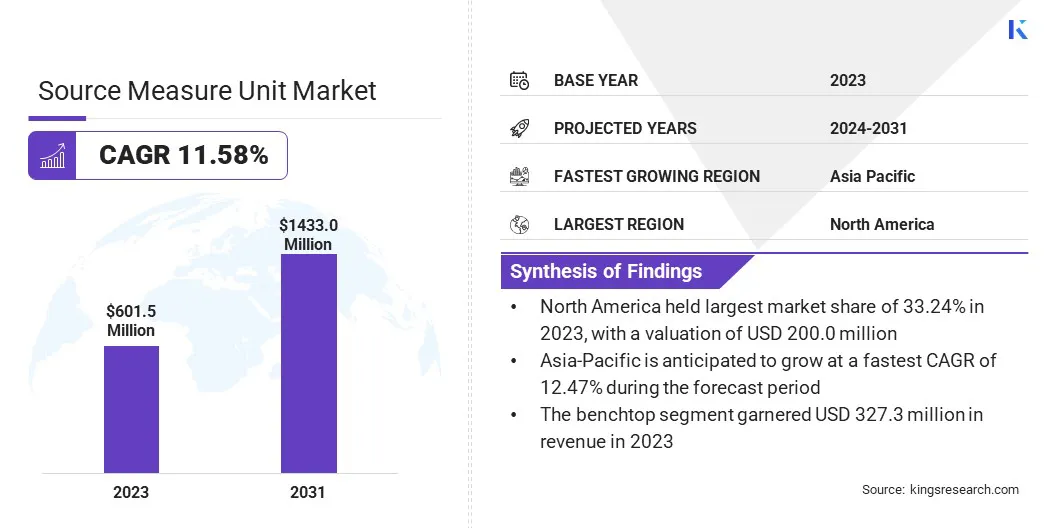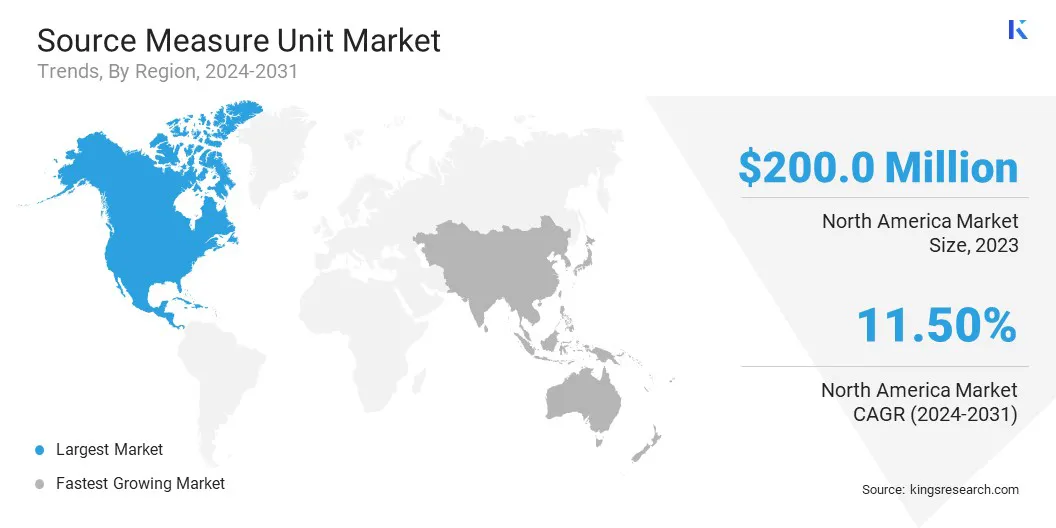Market Definition
The source measure unit (SMU) market involves the industry engaged in the development, manufacturing, and commercialization of multifunctional electronic test equipment that accurately provides and measures electrical signals in a single device.
SMUs play a vital role in testing, validation, and characterizing electronic components and devices. They are widely used in industries such as semiconductors, telecommunications, energy, and automotive electronics. In these sectors, high accuracy and testing efficiency are essential for product development and quality assurance.
Source Measure Unit Market Overview
The global source measure unit market size was valued at USD 601.5 million in 2023 and is projected to grow from USD 665.7 million in 2024 to USD 1433.0 million by 2031, exhibiting a CAGR of 11.58% during the forecast period.
The increasing demand for precise and versatile testing equipment across industries such as semiconductors, electronics manufacturing, telecommunications, energy, and automotive is driving the market.
Major companies operating in the global source measure unit (SMU) industry are TEKTRONIX, INC., Keysight Technologies, NATIONAL INSTRUMENTS CORP., Chroma ATE Inc., Yokogawa Electric Corporation, Rohde & Schwarz, VX Instruments GmbH, Ossila, Teradyne Inc., Marvin Test Solutions, Inc., Scientific Mes-Technik Pvt. Ltd., Wuhan PRECISE Instrument Co., Ltd., Aim-Tti, Emona TIMS Pty Ltd., and HIOKI E.E. CORPORATION.
Technological advancements, increasing complexity of electronic devices, and the growing need for efficient research and development tools are key drivers of market growth. Additionally, rising adoption of electric vehicles, expansion of 5G technology, and innovations in power electronics are expected to further boost the demand for source measure units.

Key Highlights
- The global source measure unit market size was recorded at USD 601.5 million in 2023.
- The market is projected to grow at a CAGR of 11.58% from 2024 to 2031.
- North America held a market share of 33.24% in 2023, with a valuation of USD 200.0 million.
- The precision segment garnered USD 231.3 million in revenue in 2023.
- The benchtop segment is expected to reach USD 794.2 million by 2031.
- The power component segment is anticipated to witness the fastest CAGR of 12.12% during the forecast period.
- The automotive segment garnered USD 161.1 million in revenue in 2023.
- The Asia Pacific is anticipated to grow at a CAGR of 12.47% during the forecast period.
Market Driver
"Growing Demand in the Semiconductor Sector"
Rising demand in the semiconductor industry is a key driver of the source measure unit (SMU) market. Semiconductors are integral to a broad range of applications, including consumer electronics, advanced automotive systems and industrial technologies.
As the semiconductor industry advances, driven by innovations in 5G, artificial intelligence (AI), the Internet of Things (IoT), and autonomous vehicles, the demand for reliable testing equipment is becoming more critical. SMUs are essential for evaluating the performance, power efficiency, and reliability of semiconductor devices across various voltage and current levels.
With the continuous miniaturization of chips and the development of more complex microarchitectures, testing requirements are becoming more stringent. This increases demand for high-precision SMUs to ensure product quality and performance.
- In July 2023, Keysight Technologies, Inc. launched the PZ2100 Series High-Channel Density Precision Source Measure Unit (SMU) Solution. It features 20 precision SMU channels within a 1U rack space, enabling faster IC characterization and enhancing development efficiency for engineers.
Market Challenge
"Operational Complexity"
The complexity of operating source measure units (SMUs) presents a significant challenge in the market. These advanced instruments require specialized technical knowledge for effective use. Their multifunctionality and precise measurement capabilities demand a deep understanding of both hardware configuration and software operation.
Selecting correct parameters and interpreting data accurately can be difficult for operators without the requisite technical expertise. This operational complexity increases the training requirements for users and contributes to higher operational costs, particularly in industries with limited access to skilled personnel.
Addressing this challenge requires manufacturers to simplify user interfaces and integrate intuitive software tools to streamline setup and testing processes. Developing user-friendly graphical interfaces, automated calibration, and built-in test presets can significantly reduce the learning curve.
Additionally, offering comprehensive training programs and enabling remote monitoring through cloud-based platforms enhances usability, minimizes errors, and supports operational flexibility across diverse application areas.
Market Trend
"Integration with Advanced Software"
The integration of advanced software with source measure units is an emerging trend significantly influencing market dynamics. Modern SMUs are increasingly being paired with sophisticated software platforms, significantly enhancing their functionality and operational efficiency.
These software solutions facilitate automated testing, real-time data analysis, and seamless control over test parameters. This makes source measure units more adaptable and precise in complex testing scenarios.
Aditionally, Software integration simplifies test setup, enhances measurement accuracy, and allows for the generation of comprehensive reports via centralized user interfaces. Cloud-based solutions offer remote monitoring, scalable data storage, and collaborative analysis, facilitating real-time troubleshooting and informed decision-making.
This trend is driving productivity gains and operational insights across key sectors such as semiconductors, power electronics, and research and development. As a result, software integration is becoming a pivotal factor in the evolution and widespread adoption of SMUs, supporting more efficient and intelligent testing processes.
Source Measure Unit Market Report Snapshot
|
Segmentation
|
Details
|
|
By Type
|
Precision, Application-specific, General-Purpose
|
|
By Form
|
Benchtop, Modular
|
|
By Application
|
Semiconductor IC component, Power Component, Sensor, Nano Material, Others
|
|
By End-Use Industry
|
IT & Telecommunications, Automotive, Healthcare, Aerospace & Defense, Process Industries
|
|
By Region
|
North America: U.S., Canada, Mexico
|
|
Europe: France, UK, Spain, Germany, Italy, Russia, Rest of Europe
|
|
Asia-Pacific: China, Japan, India, Australia, ASEAN, South Korea, Rest of Asia-Pacific
|
|
Middle East & Africa: Turkey, UAE, Saudi Arabia, South Africa, Rest of Middle East & Africa
|
|
South America: Brazil, Argentina, Rest of South America
|
Market Segmentation
- By Type (Precision, Application-specific, General-Purpose): The precision segment earned USD 231.3 million in 2023 due to its high demand for accurate and reliable testing in industries such as semiconductor, research, and power electronics.
- By Form (Benchtop, Modular): The benchtop segment held 54.42% of the market in 2023, due to its widespread use in laboratory and research environments, offering ease of use, stability, and high performance for a variety of testing applications.
- By Application (Semiconductor IC component, Power Component, Sensor, Nano Material, Others): The semiconductor IC component is projected to reach USD 384.1 million by 2031, owing to the increasing demand for advanced semiconductor devices in applications such as 5G, AI, and IoT, which require precise testing and characterization.
- By End-Use Industry (IT & Telecommunications, Automotive, Healthcare, Aerospace & Defense, Process Industries): The healthcare segment is anticipated to grow at a CAGR of 12.47% during the forecast period, driven by the rising demand for precise testing and validation of medical devices, diagnostic equipment, and wearable health technologies.
Source Measure Unit Market Regional Analysis
Based on region, the global market has been classified into North America, Europe, Asia Pacific, Middle East & Africa, and Latin America.

North America source measure unit market share stood around 33.24% in 2023 in the global market, with a valuation of USD 200.0 million. The region is expected to maintain its dominance throughout the forecast period, supported by strong demand from industries such as semiconductors, telecommunications, and automotive electronics.
North America's well-established infrastructure and the presence of leading players in the electronics and semiconductor industries further boost the adoption of SMUs in this region.
The U.S., serves as a major hub for high-precision testing in across critical sectors, including aerospace and defense, healthcare, and energy, where the need for accurate and reliable testing equipment is essential.
The source measure unit industry in Asia-Pacific is expected to grow at a robust CAGR of 12.47% over the forecast period. Rapid industrialization, and increasing investments in electronics manufacturing, semiconductor R&D, and renewable energy technologies are stimulating this growth.
Additionally, the region’s focus on enhancing manufacturing standards, combined with initiatives to advance infrastructure and innovation in power electronics, is accelerating SMU adoption
Regulatory Frameworks
- The International Electrotechnical Commission (IEC) regulates safety standards for electrical testing equipment through the IEC 61010 series, ensuring devices are safe to use while maintaining performance and accuracy.
- The European Union (EU) regulates product safety through the CE marking, ensuring products meet EU safety, health, and environmental standards.
- The Federal Communications Commission (FCC) regulates electromagnetic interference (EMI) through its guidelines for radio frequency (RF) devices. Compliance with FCC regulations ensures that electrical testing equipment does not emit harmful levels of RF interference, maintaining safe and reliable operation within the U.S. market.
- The International Organization for Standardization (ISO) sets quality management standards through ISO 9001, which ensures that manufacturers meet consistent quality, reliability, and performance standards.
Competitive Landscape
The competitive landscape of the source measure unit market is marked by a diverse range of players focusing on innovation, quality, and customer-centric solutions.
Companies are differentiating themselves through the development of more advanced and specialized source measure units that cater to specific industry needs such as semiconductor testing, power electronics, and automotive.
Strategic partnerships and collaborations are becoming more common as companies seek to expand their product offerings, enhance R&D capabilities, and enter new market segments.
The growing focus on customization and adapting source measure units to specific testing environments is intensifying competition. This pushes companies to innovate and deliver greater value to customers.
List of Key Companies in Source Measure Unit Market:
- TEKTRONIX, INC.
- Keysight Technologies
- NATIONAL INSTRUMENTS CORP.
- Chroma ATE Inc.
- Yokogawa Electric Corporation
- Rohde & Schwarz
- VX Instruments GmbH
- Ossila
- Teradyne Inc.
- Marvin Test Solutions, Inc.
- Scientific Mes-Technik Pvt. Ltd.
- Wuhan PRECISE Instrument Co., Ltd.
- Aim-Tti
- Emona TIMS Pty Ltd
- HIOKI E.E. CORPORATION
Recent Developments (M&A/Partnerships/Agreements/New Product Launch)
- In October 2024, Yokogawa Test & Measurement Corporation launched its AQ2300 series high-performance, high-speed SMU in North America. The modular AQ2300 series offers precise voltage/current generation and measurements, along with high-quality pulse generation.


